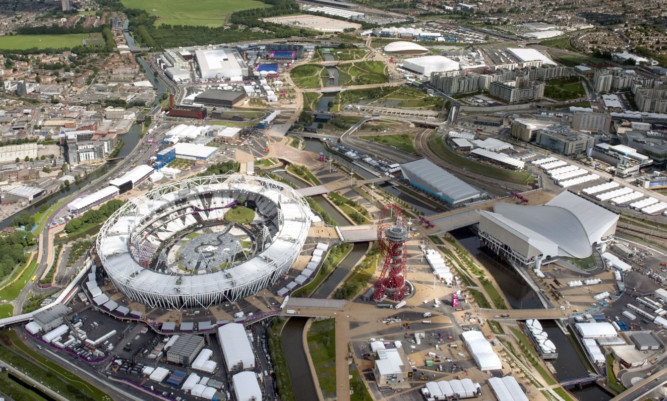
Stratford upon heaven! The Olympic Park offers a host of sporting venues as well as the ‘tower of twisted spaghetti’.
Can you believe it’s been three years since the Olympic Park was the centre of the world’s attention?
Now it’s a tranquil retreat for those wanting to escape the hubbub of one of the world’s busiest cities.
On a visit to London last week, I returned to the Queen Elizabeth Olympic Park for the first time since watching Jessica Ennis, Chris Hoy and Ellie Simmonds go for glory (admittedly I saw the first two on telly. You may remember it was quite hard to get tickets).
A £300 million redevelopment programme has turned the park into a 568-acre oasis of wetlands, lawns and activity areas with the odd world-class sporting arena dotted about and Europe’s largest urban shopping mall on its doorstep.
The Olympic legacy may not have resulted in more people taking to the playing fields of Britain as Lord Coe had hoped, but they’re certainly filling the restaurants of the Stratford City complex.
Only people that lived there would have considered the east London venue a worthwhile travel destination when the Games were awarded to London 10 years ago.
In the 1,000 years since the village of Stratford was first recorded as a River Thames crossing point on the road to Colchester, its biggest claim to fame was as the place where the Stratford Martyrs met their grisly end.
They were 11 men and two women burned at the stake for their Protestant beliefs, during the reign of Queen Mary in 1556.
A memorial still stands in St John’s Churchyard, which one wag told me was one of the few things built in the area until the Olympics came to town.
The area was heavily bombed during the war (the day after my visit an unexploded German bomb led to evacuation of the Westfield shopping centre) but, unlike other areas of London, Stratford had never benefited from regeneration in the post-war era.
It seems incredible that such a large area of what was essentially wasteland was situated so close to the heart of London for so long.
But 2012 put Stratford on the map and any trip to London now will be enhanced by a visit or, with superb tube, rail and bus links, basing yourself there for a longer stay in London.
As you would expect, sport is high on the agenda when visiting the Olympic Park.
The Aquatics Centre is now a public swimming pool and you can swim in the same lane as Michael Phelps or dive off the same boards as Tom Daley for £3.50 (£2 for children).
There are also 90-minute aqua splash sessions every Saturday, where you can test your balance and nerve as you try to make your way across a 20-metre inflatable course for £7.50 (£5 for children).
If imitating Chris Hoy or Bradley Wiggins is more your thing then there’s the Lee Valley VeloPark, which offers four different cycling disciplines track, BMX, mountain biking and road racing on a
one-mile floodlit track.
I opted for a track taster session during my stay, one hour on a fixed-wheel bike (it doesn’t have any brakes!) for £35.
I’m proud to say I reached the top of the steep banks at either end of the track but didn’t manage a speed that will give anyone in Team GB anything to worry about.
Across the road from VeloPark is the Lee Valley Hockey and Tennis Centre, which offers six outdoor and four indoors courts for hire.
Prices start at £8 an hour for adults (£5 for children and OAPs) for the outdoor courts and £15 (£10 for children and OAPs) for the indoor. The two state-of-the-art hockey pitches are also available.
The world’s leading athletes will return to the Olympic Stadium next weekend for the Sainsbury’s Anniversary Games but the shutters will go up soon after, as work continues to turn the stadium into the new home of West Ham United.
Tours of the stadium will be available when it reopens in the summer of 2016.
There is a lot of building work still going on, and the redevelopment isn’t expected to be completely finished until 2020.
If you want to see the inside of the stadium now, a trip to the top of the 114-metre ArcelorMittal Orbit tower will give you a fantastic view.
It’s also the one place on the park you can’t see the much-maligned creation which was described as being “Meccano on crack” and like “twisted spaghetti” when it was opened to the public in 2012.
Having paid your £15 entrance fee (£7 for children) to enjoy the panoramic view and some of the other delights from Turner-prize winning designer, Sir Anish Kapoor, you can either take the lift back down or, for another £70, abseil down the outside.
This needs to be pre-booked and you have to be over 18 and under 19 stone to take part.
There were places available the day I was there, but there’s not a bone in my body that wanted to jump off the top of Britain’s tallest sculpture wearing just a harness and a helmet.
A leisurely cruise on the River Lea, which snakes its way through the park, followed by sipping a coffee and eating a croissant in the Timber Lodge Caf that overlooks the Olympic rings monument is much more my style, thank you very much.

Enjoy the convenience of having The Sunday Post delivered as a digital ePaper straight to your smartphone, tablet or computer.
Subscribe for only £5.49 a month and enjoy all the benefits of the printed paper as a digital replica.
Subscribe